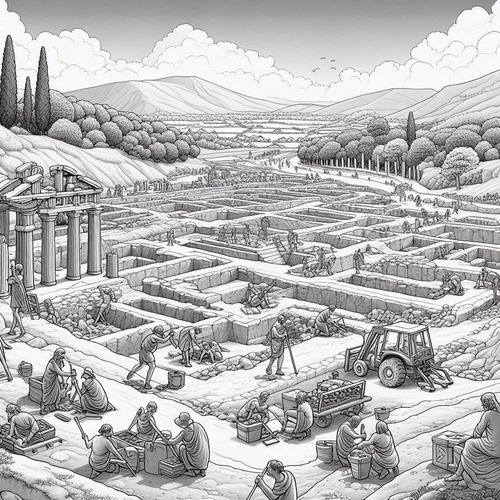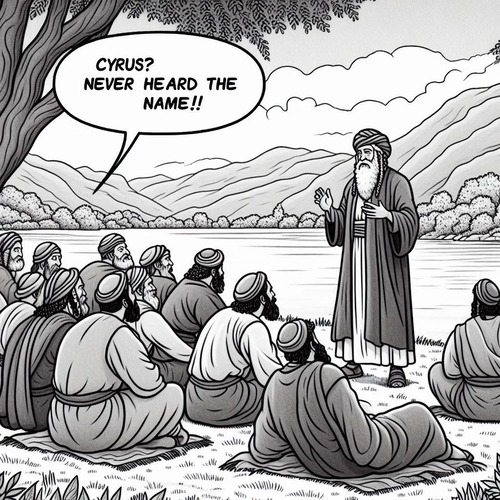Noah’s Flood: Where Did All the Water Come From? And Go?
The question hits every Bible-believing Christian at some point: “If Noah’s flood covered the whole earth, where did all that water come from? And where did it all go?” It’s an honest question that deserves an honest answer, one that takes both Scripture and science seriously while maintaining our confidence in God’s Word.
WHAT SCRIPTURE ACTUALLY TELLS US
The Bible doesn’t leave us guessing about the water’s source. Genesis 7:11 gives us two specific origins: “all the fountains of the great deep were broken up, and the windows of heaven were opened.”
- The Fountains of the Great Deep refers to vast underground water reservoirs. The Hebrew term ma’yanot tehom rabbah suggests something far more dramatic than ordinary springs. Ancient peoples understood enormous quantities of water existed beneath the earth’s surface. Modern geology confirms subterranean water systems are indeed vast—we’re talking about water stored in rock formations, aquifers, and possibly deeper geological structures that could be released through tectonic activity.
- The Windows of Heaven describes the opening of celestial floodgates. This isn’t merely heavy rain; the Hebrew arubot hashamayim suggests the systematic release of waters stored above the firmament. This echoes Genesis 1:7, where God “divided the waters which were under the firmament from the waters which were above the firmament.”
The biblical account emphasises both the supernatural timing and the natural means. For 40 days and nights, these dual sources poured forth water. Then, just as systematically, “the fountains of the deep and the windows of heaven were also stopped” (Genesis 8:2).
WHERE THE FLOOD WATER CAME FROM AND WENT: REFORMED PRINCIPLES AT WORK
From a Reformed perspective, we seek to understand the flood through the lens of divine sovereignty. This wasn’t a natural disaster that caught God off guard—it was covenant judgement executed with precision.
God’s Complete Control Over Creation means He can orchestrate natural processes in extraordinary ways. Psalm 104:6-9 describes God’s power over the waters: “You covered it with the deep as with a garment; the waters stood above the mountains… You have set a boundary that they may not pass over, that they may not return to cover the earth.”
The Supernatural Within the Natural reflects classic Reformed theology. We don’t need to choose between miracle and natural process. God typically works through means, not despite them. The flood demonstrates God working through hydrological and geological processes, but at a scale and timing that serves His covenant purposes.
ENGAGING MODERN QUESTIONS THOUGHTFULLY
The Scale Question: Scripture’s language clearly indicates a global flood. When Genesis 7:19 states that “all the high hills under the whole heaven were covered,” the Hebrew leaves no room for ambiguity. The phrase “under the whole heaven” (tachat kol-hashamayim) consistently refers to the entire earth throughout Scripture. Additionally, the need for an ark to preserve animal life only makes sense if the flood was truly global—a local flood would have allowed animals to migrate to safety.
The Physics Question: Critics claim there isn’t enough water for a global flood, but this assumes our present earth configuration. Before the flood, the earth likely had a dramatically different topography with less pronounced ocean basins and mountain ranges. The “fountains of the great deep” breaking up suggests massive tectonic upheaval that could have released vast underground water reserves while simultaneously creating new ocean basins. A pre-flood vapour canopy (suggested by the “waters above the firmament” in Genesis 1:7) could have provided additional water volume when it collapsed.
The Geological Question: The global flood provides the best explanation for the worldwide sedimentary rock layers containing billions of fossilised marine creatures found even on mountaintops. These massive fossil graveyards, rapid burial patterns, and polystrate fossils spanning multiple rock layers align perfectly with catastrophic flood geology rather than slow, gradual processes. The Grand Canyon and similar geological formations worldwide show clear evidence of rapid water erosion rather than millions of years of gradual carving.
WHERE DID ALL THE WATER GO?
Scripture is equally clear about the water’s recession. Genesis 8:1-5 describes God’s systematic withdrawal of the flood waters.
Divine Initiative: “God remembered Noah”—not that He had forgotten, but that He acted in covenant faithfulness. God caused a wind (ruach) to pass over the earth, echoing Genesis 1:2 and suggesting a new creative act.
Natural Processes Under Divine Direction: The water didn’t simply vanish—it was redistributed through evaporation, absorption into the earth, and flow into newly formed seas and rivers. Geological changes during the flood may have created new basins and altered drainage patterns. The establishment of new geographical boundaries reflects God’s promise that the waters would never again cover the earth (Psalm 104:9).
WHERE THE FLOOD WATER CAME FROM AND WENT: THE HEART OF THE MATTER
- The Flood as Covenant Judgement: This wasn’t a random catastrophe but God’s righteous response to human corruption. The flood demonstrates God takes sin seriously and that His patience, while long, is not infinite. It prefigures the final judgment described in 2 Peter 3:3-7.
- The Flood as Covenant Mercy: Even in judgement, God’s grace prevails. The preservation of Noah’s family and the animal kinds demonstrates God’s commitment to His creation. The rainbow covenant that follows shows God’s faithfulness to His promises.
WHERE THE FLOOD WATER CAME FROM AND WENT: WHERE WE STAND
As Reformed Christians, we don’t claim to have solved every scientific puzzle about the flood. We acknowledge the complexities and maintain appropriate humility about our limitations. But we stand firmly on Scripture’s authority and the God who reveals Himself through His Word.
The flood reveals both God’s holiness and His mercy. The same God who brought judgement through water brings salvation through Jesus Christ—our ultimate ark of safety. In a world that often seems chaotic and uncertain, we find comfort in knowing the God who controlled the flood waters still controls the course of history.
The water came from where God directed it to come. It went where God directed it to go. And that’s ultimately all we need to know to trust in the God who judges and saves.
WHERE THE FLOOD WATER CAME FROM AND WENT: RELATED FAQs
How did Noah fit all the animal species on the ark? The Hebrew word min (kind) likely refers to broader taxonomic categories than modern species classifications. Noah probably took representative pairs of animal families or genera, allowing for rapid post-flood diversification through natural selection. For example, the “dog kind” could produce wolves, domestic dogs, and foxes through genetic variation already present in the original pair. This significantly reduces the number of animals needed on the ark while maintaining genetic diversity.
- How do young earth creationists explain rapid post-flood geological formations? Reformed young earth creationists argue the global flood explains rapid geological formation through catastrophic processes. The massive water movements during the flood year could carve out canyons, deposit sedimentary layers, and create geological features in months rather than millions of years. They point to observed rapid erosion events, like the formation of new canyons after volcanic eruptions, as evidence that catastrophic water flow can accomplish in days what uniformitarian geology claims takes millennia. This perspective maintains Scripture’s timeframe aligns with observable geological processes when understood through catastrophic rather than gradual models.
- What role did the pre-flood vapour canopy play according to global flood advocates? Many global flood proponents suggest Genesis 1:7’s “waters above the firmament” describes a vapour canopy that surrounded the early earth. This canopy would have created a greenhouse effect, explaining the luxuriant pre-flood vegetation and the longevity of early humans. When God opened the “windows of heaven,” this canopy collapsed, providing a significant portion of the flood waters while also dramatically altering earth’s climate. The post-flood world’s harsher conditions would explain the rapid decline in human lifespans and the beginning of ice ages.
How do global flood defenders address the distribution of animals after the flood? Reformed global flood advocates explain animal distribution through rapid post-flood migration and land bridge connections. As the earth dried and stabilised, animals spread from the Ararat region across available land masses before rising sea levels and tectonic activity separated continents. Some unique species developed through rapid speciation within created kinds as they adapted to new environments. This model suggests that continental drift and climate changes happened much more rapidly in the post-flood period than uniformitarian geology allows, creating the biogeographical patterns we observe today.
- What evidence do young earth creationists cite for rapid fossil formation? Young earth creationists point to several lines of evidence for rapid fossil formation during the flood. They highlight polystrate fossils that span multiple rock layers, suggesting rapid burial rather than gradual accumulation. Soft tissue preservation in fossils, including dinosaur blood vessels and proteins, indicates recent rather than ancient burial. The presence of marine fossils on mountaintops worldwide suggests these areas were once underwater during a global flood. These observations support catastrophic burial conditions rather than the slow fossilisation processes typically assumed by old earth models.
- How do geologists explain the apparent order in the fossil record? Reformed flood geologists argue the fossil record’s apparent progression reflects ecological zonation and hydraulic sorting during the flood rather than evolutionary development over millions of years. Marine creatures would be buried first as ocean floors were uplifted, followed by lowland organisms, then highland species as flood waters rose. Larger, more complex animals might survive longer and be buried in higher layers. This ecological succession model explains the general pattern of simple-to-complex fossils while maintaining that all these organisms lived contemporaneously before the flood, not across vast geological ages.
How do we explain the survival of plants and freshwater ecosystems? A global flood would have created massive ecological disruption, yet Scripture implies rapid post-flood recovery. Possible explanations include: seeds and spores surviving in floating debris or mud deposits, God’s miraculous preservation of plant life, and the gradual separation of fresh and salt water as flood waters receded. Some suggest that floating vegetation mats could have preserved both plants and small animals. The rapid post-flood ecosystem recovery demonstrates God’s providential care for His creation alongside human preservation.
WHERE THE FLOOD WATER CAME FROM AND WENT: OUR RELATED POSTS
- Why Noah’s Flood Was Global: Scientific Evidences Often Overlooked
- Rocks Don’t Lie: 10 Global Evidences Supporting Noah’s Flood
- Ancient Flood Stories Compared: What Makes Noah’s Account Different?
- Fact Vs. Fiction: Did Rain Exist Before Noah’s Time?
- After the Flood: Did Noah Release a Raven Or A Dove?
- Why Didn’t Jesus Come Before Noah’s Flood? God’s Perfect Timing…
Editor's Pick

From Empty to Overflow: The Abundant Life Jesus Promised
(AND WHY YOU SHOULDN’T SETTLE FOR LESS) We're surviving, but are we thriving? If we're honest, there's a gap between [...]

What Does Jesus Save Us From?
THREE BIBLE TRUTHS ABOUT SALVATION "Jesus saves." We’ve seen it on bumper stickers, heard it shouted at sporting events, maybe [...]

If God Wants Everyone Saved, Why Aren’t They?
THE REFORMED VIEW ON GOD’S DESIRE VS HIS DECREE The question haunts every believer who has lost an unbelieving loved [...]

The One Man Mystery in Acts 17:26: Is It Adam Or Noah?
When the Apostle Paul stood before the philosophers at Mars Hill, he delivered an insightful statement about human unity: “And [...]

Megiddo Or Jerusalem: Where Did King Josiah Die?
Recent archaeological discoveries at Tel Megiddo continue to reveal evidence of Egyptian military presence during the late 7th century BC, [...]

Losing Your Life Vs Wasting It: How Are the Two Different?
AND WHY DID JESUS PRAISE THE FORMER? Jesus spoke one of the most perplexing statements in Scripture: “For whoever wants [...]

Can Christians Be Demon Possessed? What the Bible Teaches
Perhaps you’ve witnessed disturbing behavior in a professing Christian, or you’ve struggled with persistent sin and wondered if something darker [...]

Sacred Fury: What Christ’s Temple Cleansing Truly Means
Mark 11 records the crack of a handmade whip that echoed through the temple corridors. Tables crashed to the ground, [...]

Did Jesus Cleanse the Temple Twice?
OR DID JOHN DISAGREE WITH THE SYNOPTICS ON TIMING? One of sceptics’ favourite "gotcha" questions targets what they see as [...]

Self-Authentication: Why Scripture Doesn’t Need External Validation
"How can the Bible prove itself? Isn't that circular reasoning?" This objection echoes through university classrooms, coffee shop discussions, and [...]
SUPPORT US:
Feel the Holy Spirit's gentle nudge to partner with us?
Donate Online:
Account Name: TRUTHS TO DIE FOR FOUNDATION
Account Number: 10243565459
Bank IFSC: IDFB0043391
Bank Name: IDFC FIRST BANK






